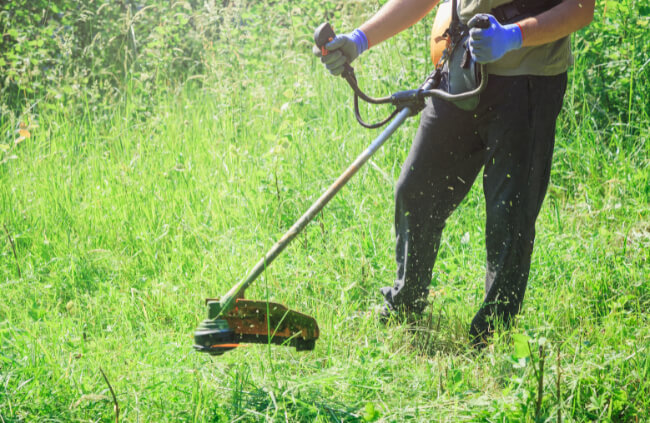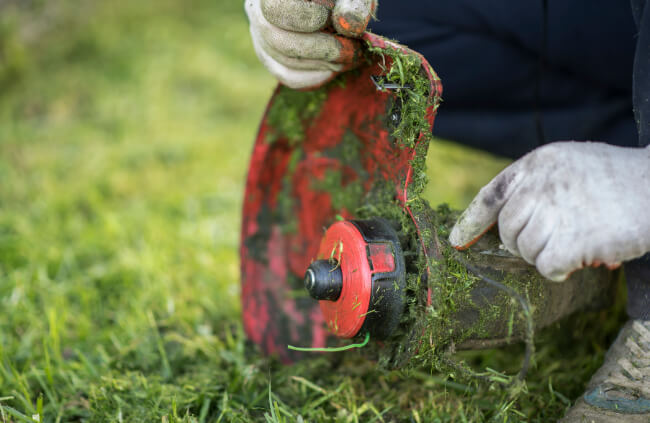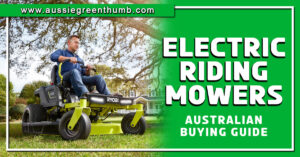Whipper snippers are a spectacular time saver with lawn care, but did you know there are tons of other ways you can use them in the garden? In this guide, we’re going to cover the basics of getting the most out of your whipper snipper and share some great tips on different ways to use them.
Plus, everything you need to know about whipper snippering, maintenance, care, and safety.
More...
When to Use a Whipper Snipper

There’s no bad time to use a whipper snipper, but there are bad ways to use them. Even in the depths of winter, they offer a simple way to tidy up dead streams and clean up your borders, but they are at their very, very best, through summer.
All the way through summer, whipper snippers turn edging your lawns from a task that can take hours, into a job that takes minutes. But, just like lawnmowers, they are best used in dry conditions, and do sometimes leave a mess behind that will need tidying up.
What are the Best Whipper Snippers to Buy?
Whipper snippers are varied tools and can vary hugely from one brand to the next. For information on specific brands, check out our guide to choosing Stihl whipper snippers and Makita whipper snippers, or for full guidance on how to choose, check out our buyer’s guide to whipper snippers.
Difference Between a Lawn Edger and a Whipper Snipper?
Lawn edgers, whether they’re manual tools like hoes, or rotary lawn edgers have solid blades used to cut between lawns and paths or trim lawn edges where they meet your flower borders. They take more control than whipper snippers but give neater results.
Whipper snippers have an advantage over lawn edgers in that they are easier to use, offer rapid results, and are much lighter tools.
Are Line Trimmers Better than Whipper Snippers?
Line trimmers, or brush cutters, are more powerful than whipper snippers. They have thicker wire and are capable of cutting through thicker materials. Whipper snippers are designed to be used on grass and young stems.
Whipper snippers are cheaper, lighter, and use less energy than line trimmers. For most gardeners, whipper snippers are significantly more practical.
The Best Uses for Whipper Snippers

Whipper snippers are best used as part of your weekly lawn care routine. After mowing your lawn, quickly run around the edges to maintain clean lines and stop grass from creeping into borders.
While that’s their intended use, they also make excellent (if slightly rough) hedge trimmers and are brilliant and quickly tidying up herbaceous plants that have died back at the end of autumn or in winter.
Setting Up Your Whipper Snipper
Whipper snippers don’t take much setting up as they usually come fully assembled, but if not, make sure the safety guard is pointed towards the user side of the tool, and the handles are firmly attached.
Installing Whipper Snipper Cord
Whipper snipper cords can be fiddly to install, but it’s not rocket science. Fresh whipper snipper cords will have both ends of the line already prepared and poking through their corresponding holes. Simply push the fitting into place until you hear a click.
Note: The above guidance is based on the majority of whipper snipper designs. Some cord cases require screw fitting.


Get Your Free Guide:
Master Growing Australian Natives eBook
A Must Have Complete Guide for Every Australian Garden
Get Your Free Guide:
Master Growing Australian Natives eBook
A Must Have Complete Guide for Every Australian Garden
Making Wires Safe
Before you get started, and before every use, make sure any cables are laid out neatly and remain behind you and the tool at all times. Cordless whipper snippers remove this hazard, but corded whipper snippers require some attention to be paid to the wire positioning during use.
How to Use a Whipper Snipper
Whipper snippers are known as low-powered edging tools, but they have so much more potential that we gardeners can unlock with just a touch of creativity.

Using a Whipper Snipper to Trim Lawn Edges
Obviously, their best use is to whip around the borders of lawns. It’s super simple to do, but thanks to their common confusion with lawn edgers, it’s worth clarifying exactly how to do it.
Whipper snippers should be used flat to the ground, so the rotation of the cords is parallel with the earth. Using whipper snippers on an angle can snap cords, tear up your lawn, and will almost certainly mean having to replace your cord more often.
Even at the edges of lawns, don’t be tempted to turn your whipper snipper on an angle as it will wear the core down quickly.
Weeding with Whipper Snippers
As well as lawn edges, whipper snippers are a quick and easy way to tackle problem weeds. It’s super easy to cut the tops of annual weeds by using them the same way you would trim lawn edges, but if you use them on loose soil, or around the base of trees, you can lacerate the roots of perennial weeds which is often enough to kill them.
By angling your whipper snipper into the base of tap-rooted weeds, you damage the root and make it harder to regrow, as well as opening up the chances of infection and killing the plant.
It’s not the most efficient use of a whipper snipper, but it’s a quick way to tackle reducing problems.
Tidying Up Paths with Whipper Snippers
Old paving will always suffer from weeds poking up through the crack. It’s a constant problem in older gardens, and toxic weed killers are rarely the right solution.
Rather than getting down on our hands and knees and scraping out the cracks, just go over them with a whipper snipper once a week in spring when weeds are starting to emerge. If they are cut back regularly enough they’ll die off permanently.
Using Whipper Snippers to Trim Hedges
Tall hedges can be tricky to tackle, and I wouldn’t advise using a whipper snipper on mature growth, but if you’re just trying to keep on top of fresh shoots at the top of a formal hedge, gently running your whipper snipper across the surface is a quick and effective way to do it.
Always use hedge shears or hedge trimmers to get the best finish, but if you’re whipper snippering weeds or lawn edges at the base of a hedge, why not give it a go to save time.
Cutting Grass with a Whipper Snipper
If your lawn mower is broken, or your lawn has gotten away from you and is longer than your mower can handle, run over it with a whipper snipper first to reduce the workload.
Whipper snippers will not produce a neatly cut lawn, but are brilliant at getting rid of long grass quickly. Another time when this is useful is for wildflower and meadow management.
We leave about half of our lawn to grow long each year, with meadow flowers, and cut back aggressively in mid-autumn to expose bare soil. That allows any seeds from wildflowers to make good contact with the soil, and sprout again in spring.
What NOT to do with a Whipper Snipper
Don’t be tempted to cut grass, or edge lawns with your snipper if it has rained. Whipper snippers on wet grass can tear up grass roots, leave a terrible mess behind, and also clog up your whipper snipper cords really quickly.
And remember that whipper snippers are not designed to compete with brush cutters. They can only cope with very soft foliage and very young growth, so don’t use whipper snippers to cut woody shrubs.
Whipper Snipper Maintenance

Whipper maintenance isn’t difficult, but it can be quite regular. Whipper snipper cords are made from fairly soft nylon wire, which wears down much faster than brush cutter cord; they also tend to clog up with wrapped grass blades when cutting anything longer than 10 cm.
Cleaning, maintaining cords, and proper storage should be regular parts of your whipper snipper maintenance. More below:
Replacing Whipper Snipper Cord
Replacing whipper snipper cord is exactly like installing it in the first place, but be careful that any springs don’t pop out (common on older tools as they stiffen with age if not maintained or oiled).
The casing around your cord reel should always be retained, and the cord reel placed into the slot (there’s usually not a right way up and the spiral works both ways).
Carefully pull the cord through the guide holes, and then through the reel casing. Replace the casing into its socket and that’s it.
How to Pull the Cord Out of a Whipper Snipper Easily
If your whipper snipper cord snaps or frays really quickly (if you’ve gone over a tree stump, stones or angled it towards hard paving), the cord can sometimes retract back into the casing.
It’s usually easy enough to pull it back out, but if you’re getting to the end of a reel it can be fiddly.
Remove the reel from the casing and make sure the wires are in a neat spiral still, then pull them back through each hole while you insert the reel into the casing, taking care not to trap the cord. Once it’s all back in place, pull as much cord as you need out.
Cleaning Your Whipper Snipper
After use, once the whipper snipper is switched off and disconnected from any sockets, use a stiff brush to remove any debris from the guard, and any long grass that might be wrapped around the reel.
Once every few months, or whenever you change the reel, it’s worth oiling the springs inside the reel casing to prevent rust.

How to Store a Whipper Snipper
Most whipper snippers are electric tools, so should always be stored somewhere dry. If you’re not going to use them for a long time, remove batteries from cordless tools and store them away in a dry container.
Safety Guidance for Whipper Snippers
Whipper snippers typically spin at around 5000 rpm. That’s fast. Wear eye protection, and sturdy shoes, and never turn the whipper snipper on while it’s pointed upwards or towards anybody.
If you need to check the cord, or remove a blockage, turn the tool off fully before checking or reaching near the blades. Before using a whipper snipper on long grass, run through it with a rake to scare any small creatures out, and warn off moths and pollinators that might be sleeping.
Check for tree roots, stones, and hard objects that will damage the whipper snipper, and could also flick back up towards you. Remove them before cutting the area.
Whipper Snippering Frequently Asked Questions
Are whipper snippers hard to use?
Whipper snippers are really quite simple to use. They aren’t as powerful as lawn edgers or brush cutters, and are usually quite lightweight. Provided you get the cutting angle right, they offer neat results for lawn edges.
Do you need a lawn edger or whipper snipper?
Lawn edgers and whipper snippers share many of the same jobs, but lawn edgers are much better for long term lawn maintenance, cutting back soil and cutting through roots and thatch to slow down creeping grass. Whipper snippers mostly just control the top growth of grass.
Why is my whipper snipper not cutting grass?
The most common reason that your whipper isn’t cutting grass is simply because the nylon cord has snapped, or retracted back into the case. If the cord is in place and fresh, it may be down to a broken motor that’s not producing the power required to spin against low friction.
Why does my whipper snipper cord keep breaking?
Whipper snipper cords will fray and wear down pretty quickly if it’s used too close to the ground, particularly hard pathways, tree roots, and stepping stones.
Wrapping Up Our Whipper Snippering Guide
Whipper snippers might not be the most powerful tool in your shed, but they’re one of the most versatile. Because they’re so lightweight, and reasonably simple to use, you can get quite creative with them as a supporting tool for lawn maintenance, and landscape maintenance too.
And before we go, it’s worth reiterating one thing. Like every other garden job, maintaining your lawn edges will be easier, and look better, if done regularly. Don’t treat a whipper snipper as a clean-up tool if you can avoid it, use it as part of a regular maintenance routine for best results.
Published on August 22, 2023 by Gary Clarke
Last Updated on October 25, 2023




